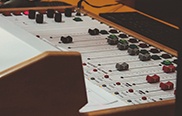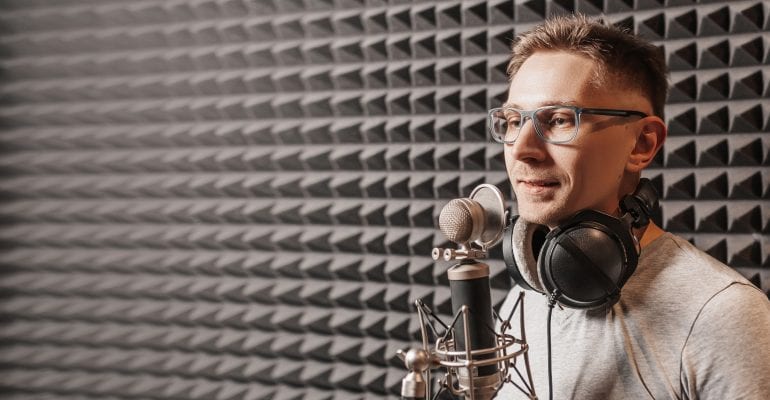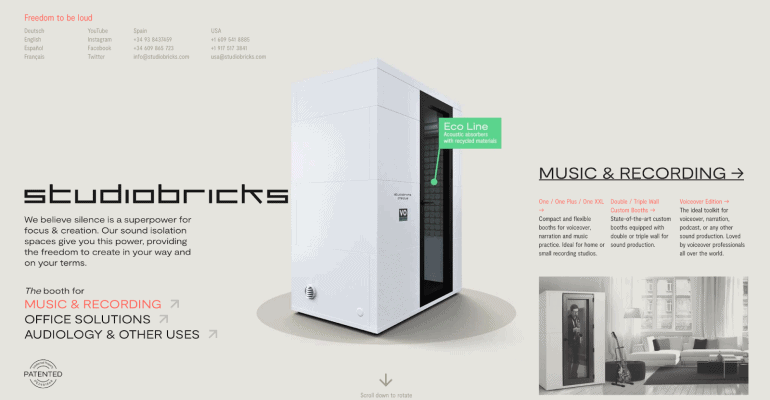Home studios are a convenient and cost-effective way to record voice over.
While commercial studios used to be the standard, most voice actors now work from home.
On one hand, this makes it easier than ever for new voice actors to get started in a budget studio.
On the other, setting up an adequate home studio can be tricky — particularly for people who don’t have audio production experience.
Fully soundproofing a room requires specialized equipment and strong attention to detail.
In this article, we’ll go over how soundproofing works and explain how to effectively soundproof a home recording studio.
Soundproofing vs. Acoustic Treatment
Many people confuse soundproofing with acoustic treatment.
While both are vital for voice actors, it’s important to understand the difference.
- Soundproofing is the process of sealing off a room so that sounds can neither leave the room nor enter from outside. It’s extremely difficult to make a room perfectly soundproof, but you can get surprisingly close with some basic equipment.
- Acoustic treatment is all about improving sound quality within a room so that sounds come through as clearly as possible. Acoustic treatment usually involves minimizing reverberation with sound-absorbing panels.
5 Steps to Soundproof a Home Recording Studio
1. Pick the Right Space
The right layout and equipment can dramatically improve audio quality, but they can’t fix everything.
Soundproofing will be much easier if you choose a space that’s suited to the task.
First, make sure to pick a room that is insulated from kitchens, bathrooms, laundry rooms, and any other noisy rooms.
You should also avoid windows that face the street (or your loud neighbors).
Consider any other elements that could impact audio quality.
Hardwood floors, for example, will increase reverberation and make acoustic treatment more difficult.
2. Start with the Door
As you might expect, your biggest soundproofing concerns will be the doors and windows.
First, consider if there are any glass doors in the room you’re planning to use.
Glass doors will make the soundproofing process significantly more expensive. 50
If you do opt for a glass door, make sure it’s double-paned and has an STC (Sound Transmission Value) of at least.
The same concept applies for doors made from particle board or other low-density materials.
You’ll also need to deal with any gaps between the door and the ground.
If your doors don’t go all the way down, you can install door sweeps to block outside sounds from entering the studio.
3. Use Recording Studio Windows
Once you’ve dealt with the doors, you can start working on your windows.
The more noise coming through the window, the more you’ll need to soundproof.
Fortunately, you can block a lot of ambient noise with the right equipment — particularly soundproof windows.
The specific characteristics vary between models, but soundproof windows typically “surround” the main window with an extra pane on both the inside and outside.
One key aspect of soundproof windows is that one of the panes is angled in order to minimize reverberation.
Note that general vendors like Home Depot may not be able to cater to the specific needs of soundproofing.
You’ll probably be better off with a specialty provider with soundproofing experience.
4. Insulate the Walls
Doors and windows should be your top priority, but you may also need to soundproof the walls for optimal acoustics.
This isn’t as much of an issue if you live in your own house, but it can be tricky for those who live in apartments with shared walls
Fortunately, you can block out most of these sounds with insulation.
The most effective option is mass-loaded vinyl (MLV), a vinyl-based barrier with excellent noise-blocking properties despite its relatively thin frame.
It can be installed on walls as well as ceilings and doors.
Alternatively, you can also add a second layer of drywall on top of the original.
Use a thicker sheet of drywall such as ⅝” to maximize the soundproofing effect.
We also recommend placing a soundproof substance like green glue between the two layers.
Check out the video below for more wall soundproofing ideas.
5. Get an Isolation Booth
Naturally, the three tips above assume that you’re working in a basic room in your home.
That’s the best choice for many enthusiasts and professionals, but you may also want to consider a dedicated isolation booth.
Isolation booths are pre-built structures that offer high-quality soundproofing and acoustics in a small space.
Like other acoustic equipment, isolation booths come in different shapes and sizes.
Shown below, the StudioBricks isolation booth is only slightly larger than a phone booth.
It comes with a sleek, professional design and built-in acoustics — no legwork required on your part.
With an isolation booth, you won’t have to worry about soundproofing or treating the room itself.
As long as you have enough physical space to fit the booth, you’ll be able to start recording as soon as you get it.
Of course, isolation booths also come with some obvious downsides.
First, you’ll need somewhere to store the booth when it’s not in use.
Before purchasing, check the dimensions to make sure you have enough space.
Furthermore, your recording space will be restricted by the size of the booth.
With a soundproof studio, you’ll be able to use the entire room.
If your only recording area is a small booth, you’ll have to fit all of your equipment into that limited space.
Ultimately, the best way to set up your recording space depends on many different factors such as your budget, level of ambient noise, and amount of available space.
Is Soundproofing Enough?
If you want to be a professional voiceover artist, you can’t afford to have background noises appearing in your recordings.
With that in mind, soundproofing is absolutely critical for anyone who’s serious about advancing in the industry.
Still, it’s just one of many tasks involved in optimizing a home recording environment.
Aside from background noises, there are a variety of other acoustic issues that could impact the finished product.
Equipment
While soundproofing and acoustic treatment should be your top concerns, you’ll also need some recording equipment.
You can start out with entry-level gear to save money, but make sure to at least get something you’re happy with.
The first thing to think about is a microphone.
USB mics are a budget option, but mics with XLR connectors are better for professional use.
Depending on quality and whether you opt for a used or new model, you can expect to spend anywhere from one or two hundred dollars to $1,000+ for a professional microphone.
Software
Software is nearly as important as hardware when it comes to recording quality.
Digital audio workspaces (DAWs) streamline various aspects of recording such as editing tracks, removing background noise, and connecting different audio sources.
The right voice over software for you depends on your budget, the features you need, and which programs your clients use.
Check out our list of the best voice over software for more information.
While noise filter plugins are a common method of minimizing unwanted noise, you should be very careful about how you use these tools.
Even if they successfully remove some noises, they may also add unnatural artifacts that stand out in the recording.
Soundproofing and acoustic treatment should always be your primary tools, with software only used to fill in the gaps.
Acoustics
Keeping external sounds out is only half the battle — you also need strong acoustics within the room.
Rooms that are small, symmetrical, or have lower ceilings are more likely to have issues with acoustics.
Remember that hard, smooth surfaces tend to reflect sounds more strongly compared to soft, textured surfaces like carpets and rugs.
Furniture, lamps, TVs, computers, and other items can have a distinct effect on acoustics.
Nowadays, you can buy absorption panels and diffusers at relatively affordable prices to minimize acoustic reflection.
Absorption panels are built with specific materials and densities to absorb mid to high frequencies and minimize sound reflections from the room’s walls.
Diffusers are used to prevent sound waves from building up in certain areas, giving recordings a wide sense of openness.
Finally, bass traps are extremely important when it comes to acoustics — especially in smaller rooms.
Low-frequency and high-frequency sound waves have very different properties, and conventional absorption panels won’t work as well for lower ranges.
Given their higher energy and longer waveform, they require absorption panels with a much higher density.
Strategically-located bass traps help prevent low-frequency build-up and maintain a more balanced sound.
Final Thoughts
Setting up your first home studio is a major step, and it can feel overwhelming if you don’t have much experience.
Fortunately, modern equipment has streamlined this process more than ever before.
In 2024, you can create professional recordings at home with relatively small investments of time and money.
With these tips, you’re ready to build a home studio that fits your needs and allows you to pursue your career as a voiceover artist.
If you’re looking to hire a professional voice actor with the ability to produce broadcast-quality audio recordings, don’t hesitate to visit our website and take a listen to our fully-vetted, professional voice talent.







2 Comments
Gracias por compartir esta información. Saludos desde COL.
Muchas gracias a ti 🙏